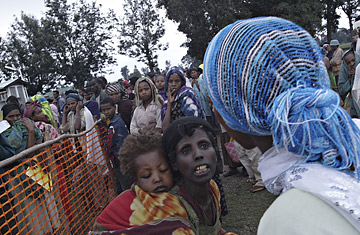
People seeking assistance at a clinic run by the NGO Medècins Sans Frontieres in Ethiopia,
All morning in the village of Kersa, the hills have echoed with the wails of women walking in from the fields. They gather on a patch of open grass before a stretcher made from freshly cut bamboo, bound and laid with banana leaves. On it is a small bundle wrapped in a red and blue blanket. An imam calls the crowd together, asks them to take off their shoes and arranges them in two lines, women behind men, facing east. "Allah Akbar," he says twice. Then four men pick up the bier, easily handling its weight with one arm, and walk a short way to a freshly dug hole, into which they lower the bundle and bury it. Three other small, fresh graves nearby indicate Ayano Gemeda, 6, was not the first child to starve in Kersa this year. The distended bellies and chicken-wing limbs on other children looking on suggest he won't be the last. "It's very bizarre," says Jean de Cambry, a Belgian member of Medecins Sans Frontieres and a veteran of crises from Afghanistan to Sudan. "It's so green. But you have all these people dying of hunger." The reasons are paved in the good intentions of rich nations, good deeds that have punished Ethiopia with perpetual want.
The day photographer Thomas Dworzak and I arrived at Kuyera, four children died. There were four more the next day. Hundreds queued with their parents in the rain outside the gates, waiting to be weighed and measured. Inside, children were sectioned by age and urgency. Each were given red and green plastic bowls for diarrhea and vomit. On that first day, I glimpsed Ayano in the intensive care room, wrapped in a red and blue blanker, struggling to breathe, his eyes tipped back into his skull. When I next saw him, he was trussed up the blanket that had become his death shroud, lying on a slab next to two other small bundles in the morgue.
Transport was scarce. So for five days, we turned our hired SUV into an ambulance, ferrying bodies of dead children back to their villages, picking up the starving and taking them to Kuyera. It was depressing work, and insufficient. The two children — Nuritu, 6, and Gemechu, four months — we picked up in Kersa were just the most emaciated among scores that needed help.
The trips to the villages provided glimpses into how emergency food aid worked — or didn't. Hundreds of millions are spent on immediate food relief because the popular notion is to alleviate the plight of starving children. But that means little is spent on economic development to prevent the shortages that led to hunger in the first place. Says Mafa E. Chipeta, East Africa coordinator for the United Nations Food and Agriculture Organization: "This is not an emergency only for this year. This is a persistent problem that we have failed to deal with. Aid needs a complete rethink." In many places, because food comes so abundantly from abroad, local farming is an undeveloped and unreliable source of sustenance. The farmlands may appear teeming but Ethiopians know enough not to trust it. And so, food is apportioned with Malthussian rigidity.
This was evident when we ferried one mother, Medina Wago, with the body of her six-month-old daughter back to their village of Sedeguge. Medina told us Feyinae was the third of her many children to die. The fields of Sedeguge were a patchwork of bright greens and deep, moist browns. Inside the family hut were five full sacks of maize.
Another day, we took Germeda Koro from Kuyera, where he was caring for his daughter Ramete, 6, to Gode village for the funeral of a neighbor's child. Koro said 20 children had died in Gode. The surrounding fields were overflowing with abundance. On the drive in, we passed a roadside auction for potatoes, huge yellow boulders stuffed 50 kg to a sack. When I asked Koro why people didn't kill the goats, cows and chickens that roamed the village to save their children, he replied: "Look, maybe one or two of your children get sick every year. But if you kill your animals, you're ruining everything you have, and everything you're going to have. You're risking the lives of the whole family." Even the decision to take a starving child to hospital — and spend a family's life savings on a bus ride — was agonizing. The children who died mostly belonged to parents who, hoping for a miraculous recovery, left it until too late.
The UNFAO's Chipeta said he thought the world food crisis might help Ethiopia in the long-run. Shortages and higher prices would cut food aid. The immediate effect would be harsh, and thousands would die. But if Ethiopia were ever to feed itself, he argued, "you have to make sacrifices at some point." In the villages, they were already making sacrifices. Children were being left to die so a family might live. That's a calculation that can strike outsiders as cruel. Some conclude life in Ethiopia is cheap. That's would be a mistake, as anyone who has heard the funeral wails can tell you. Because of food aid, Ethiopians have learned to make the tough choices. With reporting by Kassahun Addis/Addis Ababa
